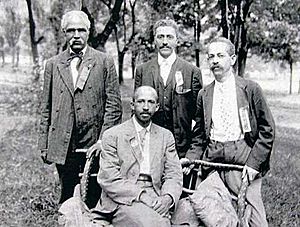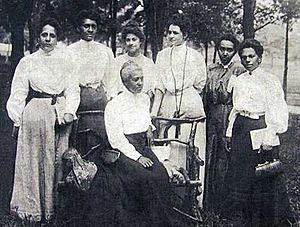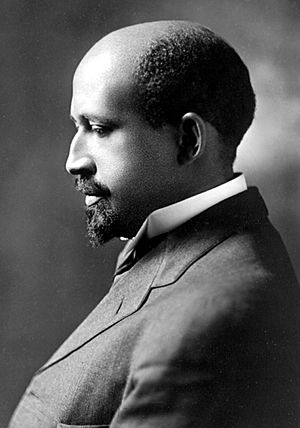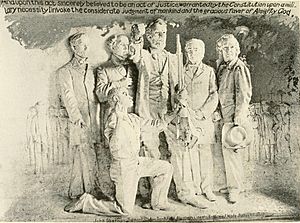Freeman H. M. Murray facts for kids
Quick facts for kids
Freeman Henry Morris Murray
|
|
|---|---|

Niagara Movement leaders W. E. B. Du Bois (seated), and (left to right) J. R. Clifford (who organized the 2nd meeting), Lafayette M. Hershaw, and F. H. M. Murray at Harpers Ferry.
|
|
| Born | September 22, 1859 Cleveland, Ohio, U.S.
|
| Died | February 20, 1950 (aged 90) Alexandria, Virginia, U.S.
|
| Alma mater | Mount Pleasant Academy, Howard University |
| Occupation | Journalist, Real Estate, Clerk |
| Spouse(s) | Laura Hamilton, Delilah |
Freeman H. M. Murray (born September 22, 1859 – died February 20, 1950) was a smart thinker, a person who fought for equal rights, and a writer for newspapers. He lived in Washington D.C. and Alexandria, Virginia.
Murray worked hard to help Black people own homes. He also fought against unfair Jim Crow laws, which separated people by race. He spoke out against lynching, which was a terrible act of violence. Murray also wanted to make sure Black people were shown in a good way in public art.
He was one of the people who started the Niagara Movement. He also helped edit its magazine, the Horizon, with W. E. B. Du Bois and Lafayette M. Hershaw. Murray was a key leader and wrote an important book about art. He was one of the first people to write about the history of African American art. His work showed that he wanted art to truly represent African Americans. He also believed that slavery should not be forgotten when showing heroes in public art.
Contents
Early Life and Family
Freeman Henry Morris Murray was born on September 22, 1859, in Cleveland, Ohio. His father, John M. Murray, was from Scotland. His family disowned him for marrying a Black woman. John fought in the U.S. Civil War with the 12th Ohio Infantry. He died in 1862.
Murray's mother was Martha Bently. Her father was Irish, and her mother was Native American and African American. Murray's parents owned a business that made clothes in Cleveland. After his father died, his mother moved the family to Cincinnati, Ohio.
After elementary school, Murray went to Mount Pleasant Academy to become a teacher. He was one of only three Black students there. He finished school in 1875. Murray loved books and learned French and Latin. He also worked with his mother's father, Daniel Bentley, in his painting business. Daniel Bentley was a big inspiration for Murray. He had helped people escape slavery through the Underground Railroad. He kept working for African American progress after the Civil War.
Later, Murray moved to Covington, Kentucky to teach. He also learned about editing and publishing at the Cincinnati Enquirer newspaper. As an adult, he studied at Howard University in Washington, DC. He eventually learned five languages.
In 1883, Murray married Laura Hamilton. They had five children. One daughter, Kathleen Paige Murray, worked for the Niagara Movement. In 1898, his daughter Mary Vivian and his wife Laura died from tuberculosis. On September 1, 1898, Murray married Delilah. They had one daughter, Florence Rogers. Murray died on February 20, 1950, in Washington, DC.
Moving to Washington, D.C.
In 1884, Murray passed a special test to work for the government in Ohio. He then moved to the Washington, DC area. He got a job in the War Department, which was part of the U.S. government. This made him the first Black person from Ohio to get a federal job.
Murray moved to Alexandria, Virginia, and started a real estate business. He bought a large house that he called a "post Civil War Underground Railroad System." It was a safe place for African Americans who were in danger. With his brother, John, he started the Murray Brothers Printers and Publishing Company.
Murray was very active in politics and fighting for African American rights. He worked with important leaders like Frederick Douglass, Ida B. Wells, and W. E. B. Du Bois. Murray worked closely with Ida B. Wells to fight against lynching. After Frederick Douglass died, Murray became the caretaker of the Frederick Douglass Memorial Cemetery.
Murray often wrote and spoke against Booker T. Washington. He felt that Washington's ideas were not strong enough to bring about the big changes needed.
In 1890, Murray and others formed the New Era Building Association. This group helped Black people buy homes and save money. In 1891, Murray and other leaders were chosen to fight against laws that separated people by race on trains in Virginia.
Murray ran a newspaper called the Home News. He also wrote for many other newspapers and magazines, including the Boston Guardian. In the 1910s, Murray was an officer for the American Negro Academy. He also started another newspaper, the Washington Tribune.
The Niagara Movement
Murray was one of the first members of the Niagara Movement. W. E. B. Du Bois started this group in 1906. Murray was an important member. He gave the opening speech at the group's second national meeting in August 1906. The Niagara Movement was an early version of the NAACP.
In 1907, Murray and others were speaking out against Booker T. Washington's Tuskegee Institute and President Theodore Roosevelt. Washington's assistant tried to get President Roosevelt to take action against members of the Niagara Movement who had federal jobs. He succeeded in getting Murray demoted from his government position.
The Horizon Magazine
To share the ideas of the Niagara Movement, Du Bois, Hershaw, and Murray started a magazine called "The Horizon." The magazine was published from 1907 to 1910. Murray was the printer, and Du Bois and Hershaw were the main editors.
Hershaw often wrote a section called "The Out-Look," which showed how the Black experience looked from the white world's point of view. Murray wrote "The In-Look," which shared the Black experience from the view of Black people and the Black press. Du Bois wrote "The Over-Look" about any important issue for Black people. Murray's "The In-Look" often criticized the less radical ideas of Booker T. Washington.
The people working on the magazine did not always agree. Hershaw and Murray often argued about what to include in "The Horizon." In 1908, some members, including Du Bois, left the magazine and the movement. They wanted more radical change.
Art History Work
In 1916, Murray wrote an important book called Emancipation and the Freed American in Sculpture. In this book, he talked about how African Americans were shown in sculptures. Murray wanted to see more progress in African American culture and art.
His book focused on how sculptures that celebrated freedom often showed heroes and battles. But they often did not show slavery itself. Murray worried that this would make people forget the important role of slavery in history. His ideas about how art shows history and memory have influenced many scholars since then.
Later Years
Later in his life, Murray started and led the Alexandria Dramatic Club. He was also a religious leader and teacher in Alexandria. He was the head of the primary Sunday School at Roberts Chapel Methodist Church, where he also taught.




